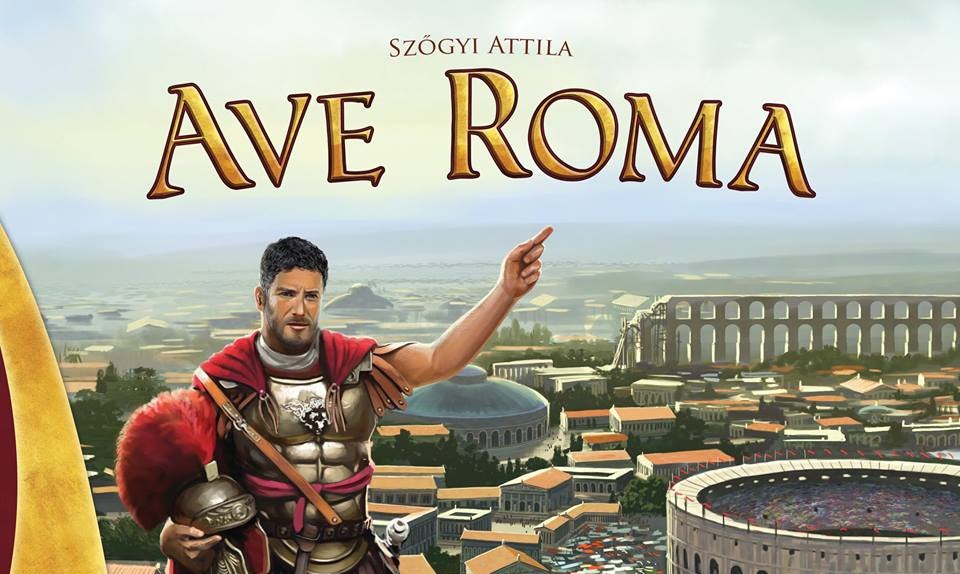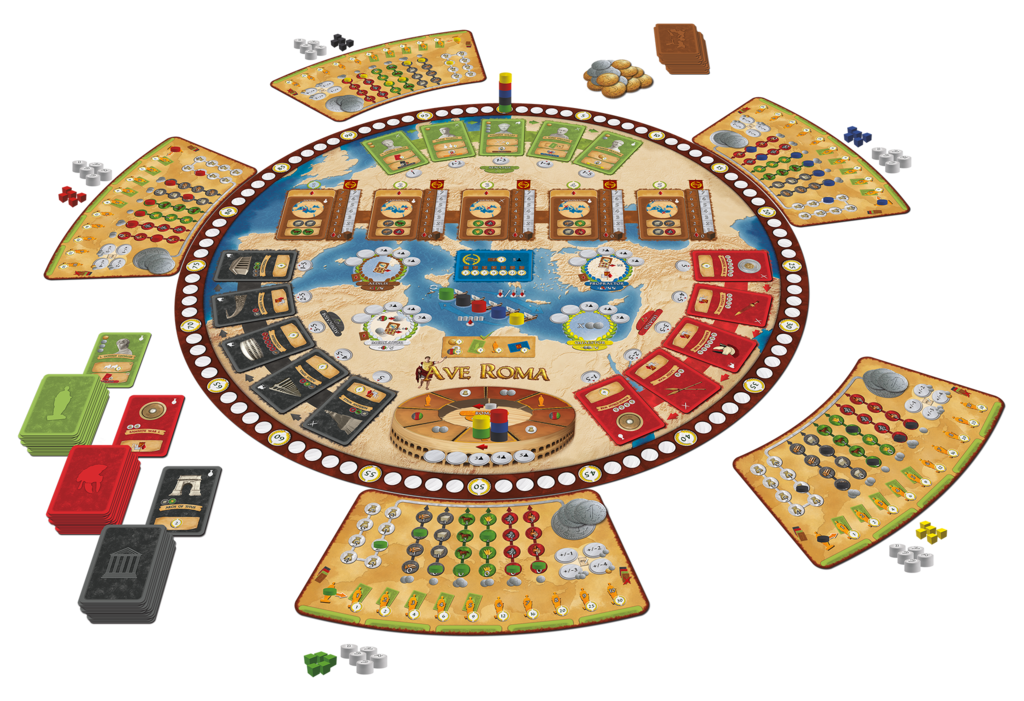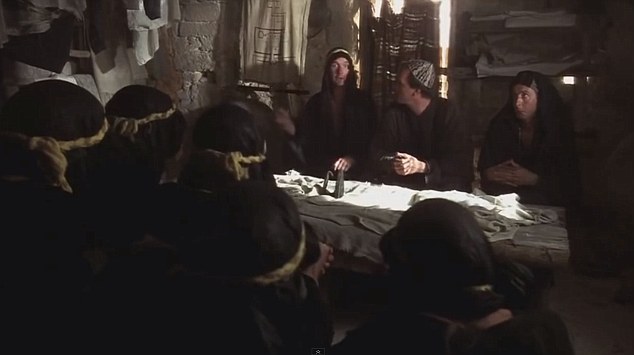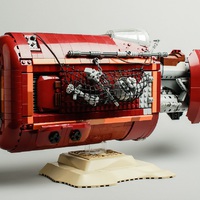
After Hungarian success stories of [redacted] and Trickerion here comes the freshly started Kickstarter campaign of Ave Roma. However there are a junk of mid-weight worker placement Eurogames on the hobby game market (and Kickstarter), Ave Roma provides enough unique ideas and game experience to put it on your radar. As per the designer the game were designed, balanced and tested for years which is definitely reflected on the final product.
Spoiler alert: this game is really really good!
Ab ovo
If you check Ave Roma’s page on BoardGameGeek it combines worker placement, trading and set collection mechanisms. You need to put out “your” workers on the action spaces you can find on the circle-shaped map, resolve your actions (including gathering and trading resources defined by prices printed on your personal player board) and collect cards which may also collect for their symbols to score victory points.
The box includes the above mentioned circle-shaped main board (which hopefully will be two-sided for the advanced game variant, see the relevant stretch goal on the campaign page), 5 unique player boards, 4 decks of cards, a nice amount of wooden tokens in player colors and cardboard denars.

On the main board you can find the action spots where you can put the workers on, the scoring track, the player order track and a final scoring aid. The game is language independent, everything is told by easy-to-understand icons.
On your player board you can manage your resources (6 basic resources in 3 colors), patrons, treasury and surplus. On the left hand side of the board you can collect your “unused” cards which you put on the right hand side when you use them, on the bottom side you can put your active patrons. Also there’s a special action space where you can send the workers to Training, this way you can modify the value of them. As your actions are restricted by the value of the worker (from 1 to 5) it’s a pretty useful option!
There are three phases in a turn: you put out the workers and resolve the actions, you refill the empty card spaces on the board and in reverse player order you collect workers from the board for the next turn and determine the new player order.

The most important twist on the worker placement genre (which makes this game really unique and special) is the worker value system. On the first turn every player gets five workers with values from 1 to 5. When you put out them on the board your actions and options are determined by the worker’s value (e.g. you can buy a card only if your worker values 1 – 3 or you can use area only #2 area card on the board if you put worker #2 on the action spot).
Once the first round is done in reverse order the players collect them for their next round (until everyone has 5 workers again) so your workers will probably defer from the starting hand of 1 – 5. So if you want to gather resources and also influence #3 area you can do it if you put out two #3 workers in the next round. Because of this you need to develop your strategy and think ahead. Fortunately you’re not restricted by this rule too heavily as you can send your workers to Training (for money in most cases, of course), so you can make some tactical decisions if your opponents blocks you to have the desired worker. Also, you can pass even if you still have workers in front of you and save them for the next round and you can score 1 VP for each of them.

The game length is determined by the cards: once you cannot refill a spot on the board the game ends and final scoring begins (and you have the option to flex the play time by adding or removing cards from the draw decks).
In Ave Roma there isn’t an only-way-to-victory as you can score point on various ways as you have several options to score points or gather resources and cards.
During our games we have never felt that we are out of options and this is the most fantastic thing about Ave Roma!
You might ask, “OK but how do you score victory points?” Of course, you need to send out the workers to the spots on the board. There are three spots where you can purchase cards:
- At Senatus you can get patrons who provide a special power until they are in effect from one hand and also can score special victory points at the end of the game
- At Legatus you can contribute to war efforts of the Empire to score VPs and/or provide influence points you can use later in the game
- At Aedificator you can buy buildings which rewards you like Legatus cards
There are other spots on the board where you can interact with the Area cards:
- At Propraetor you can get some resources from a specific area (determined by the # of the worker you sent there) and most importantly influence that specific area which can provide a good amount of VPs at the end of the game.
- At Aedilis you can simply gather all resources from the area you selected by your worker.
- At Mercator you can sell any of your basic resources and buy those which are available on the area card.

Once an area card is used for the second time two things happen: the player gets the area card (it’s replaced from the Area deck) and the maximum VP value of the spot increases, so the more you use a specific Area spot on the board the more VP you can gather from it!
There are two other places you can send your workers:
- At Questor you can get money (depending on the number on your worker)
- At Roma you can increase your political power (of course, it’s not free) to gain end-game VPs and allow you to use more and more patrons you can gather at Senatus

Advanced variant
We had the chance to play with the advanced variant and it was a relief to see in this case it does not mean overcomplicating the rules and increase the play time but increasing the pace of the game (the decks are depleting faster) and providing more options to choose from and score VPs.
In this mode there are secondary actions on each of the spots you can use by spending sets of symbols on the cards on your active card pool. For example this way you can make certain cards cheaper by using those cards as well which were not usable on the basic variant (Area and VP-only Legatus and Aedificator cards).
Verdict
Ave Roma is much more a gamers’ game so we recommend it highly to more experienced players who enjoy Stefan Feld-style games (e.g. The Castles of Burgundy, Macao, Notre Dame). The game requires constant focus on your and your opponents play as well and sometimes you need to re-plan your actions as quick as possible. This is not a game which allows you to chat during the game.

So, apart from the round-shaped board, the unique gameplay, the tricky trading, the twisted gathering, flexible playing time, the charismatic patrons what has Ave Roma ever done for us? You might answer, if our review rose interest in you towards this game and you support the project on Kickstarter to get a copy of it.
-KralleKralle, Mr. Lehel
The game prototype was provided by A-Games to us but our opinion is not influenced by them. Thanks for the opportunity to play this game and we cross our fingers for the successful KickStarter campaign!
A bejegyzés trackback címe:
Kommentek:
A hozzászólások a vonatkozó jogszabályok értelmében felhasználói tartalomnak minősülnek, értük a szolgáltatás technikai üzemeltetője semmilyen felelősséget nem vállal, azokat nem ellenőrzi. Kifogás esetén forduljon a blog szerkesztőjéhez. Részletek a Felhasználási feltételekben és az adatvédelmi tájékoztatóban.
Kommentezéshez lépj be, vagy regisztrálj! ‐ Belépés Facebookkal











